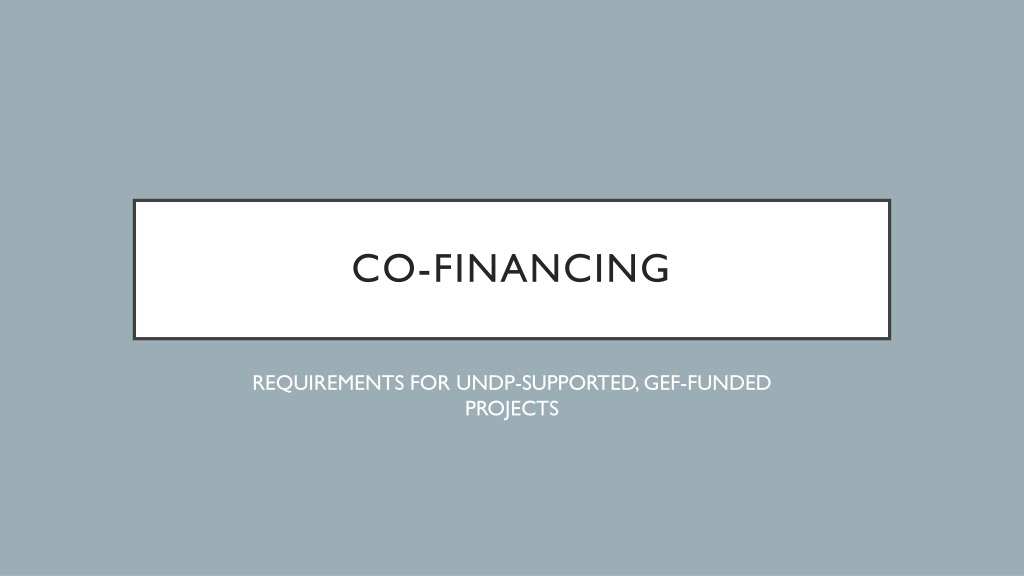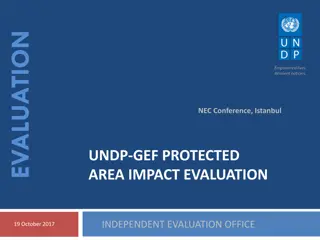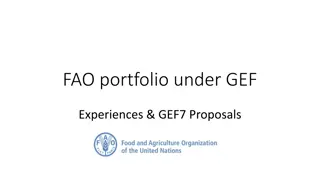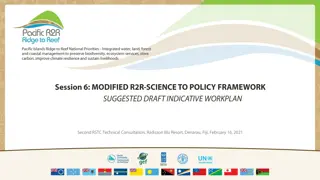Understanding Co-Financing Requirements for UNDP-Supported, GEF-Funded Projects
Co-financing for GEF-financed projects refers to additional resources provided by the GEF Partner Agency or other non-GEF sources to support project implementation and goals. The sources of co-financing include various entities such as bilateral aid agencies, foundations, governments, civil society organizations, and the private sector. The types of co-financing can include grants, loans, guarantees, in-kind contributions, and more. Responsibility for co-financing lies with the project manager and team, along with the Portfolio Manager at UNDP, who report on it during midterm and final evaluations. The co-financing ratio is calculated by comparing non-GEF resources to GEF grant resources. Co-financing is essential for achieving project objectives and should be aligned strategically with financing priorities through regular meetings with partners.
Download Presentation

Please find below an Image/Link to download the presentation.
The content on the website is provided AS IS for your information and personal use only. It may not be sold, licensed, or shared on other websites without obtaining consent from the author. Download presentation by click this link. If you encounter any issues during the download, it is possible that the publisher has removed the file from their server.
E N D
Presentation Transcript
CO-FINANCING REQUIREMENTS FOR UNDP-SUPPORTED, GEF-FUNDED PROJECTS
WHAT IS CO-FINANCING? Co-financing for GEF-financed projects is defined as resources that are additional to the GEF grant and that are provided by the GEF Partner Agency itself and/or by other non-GEF sources that support the implementation of the GEF-financed project and the achievement of its objectives (p.1, GEF Co-Financing Policy available at http://www.thegef.org/sites/default/files/documents/Co-financing_Policy-2014_0.pdf )
WHAT ARE THE SOURCES? Bilateral Aid Agency(ies), Foundation, GEF Partner Agency, Local Government, National Government, Civil Society Organization, Other Multi-Lateral Agency(ies), Private Sector, Other WHAT ARE THE TYPES? Grant, Soft Loan, Hard Loan, Guarantee, In-Kind, Other
WHO IS RESPONSIBLE? Project manager together with the project team Portfolio Manager CO UNDP WHEN DO WE REPORT ABOUT CO- FINANCING? In both midterm and final evaluations.
HOW TO CALCULATE THE CO- FINANCING RATIO? The co-financing ratio is determined by the total of non-GEF resources provided for a project compared to GEF grant resources, including the GEF Project Grant and Project Preparation Grants. Enabling activities, which do not require co- financing, will not be counted in the overall portfolio co-financing ratio. p.3, GEF Co-Financing Policy available at http://www.thegef.org/sites/default/files/documents/Co-financing_Policy-2014_0.pdf
CO- FINANCING IN MIDTERM REVIEW Source: page 48 of GUIDANCE FOR CONDUCTING MIDTERM REVIEWS OF UNDP-SUPPORTED, GEF-FINANCED PROJECTS available at http://web.undp.org/evaluation/documents/guidance/GEF/mid-term/Guidance_Midterm%20Review%20_EN_2014.pdf
CO- FINANCING IN FINAL EVALUATION Source: page 39 of GUIDANCE FOR CONDUCTING TERMINAL EVALUATIONS OF UNDP-SUPPORTED, GEF-FINANCED PROJECTS available at http://web.undp.org/evaluation/documents/guidance/GEF/UNDP-GEF-TE- Guide.pdf
THINGS TO THINK/WRITE ABOUT Is co-financing being used strategically to help the objectives of the project? Is the Project Team meeting with all co-financing partners regularly in order to align financing priorities and annual work plans? Do you remember to report yearly?























